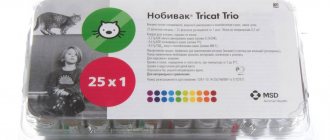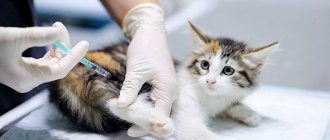Unfortunately, kittens often die due to various diseases, and the main reason for this is the lack of vaccinations. After all, vaccination is an opportunity to avoid contracting a viral or microbial infection.
That is why it will be useful for every owner to learn how to prepare for vaccination, which drug to choose, and how to cope with possible complications.
Do cats need vaccinations?
The answer is clear - it is necessary. This way the owner will protect the animal from a number of health problems. But the risk of getting a bacterial or viral infection remains.
Prejudice against vaccination:
- Domestic cats do not need to be vaccinated;
- outbred animals have strong immunity;
- kittens from the nursery do not need vaccinations;
- A purebred cat does not need vaccination if it does not participate in competitions and exhibitions.
The mistaken position of pet owners is not to vaccinate their kitten because it lives at home and does not go outside. They forget that harmful microorganisms can enter the apartment on shoes and outerwear.
Expert opinion
Chepa Natalya Semenovna
Veterinarian
Ask an expert
How else can a domestic cat become infected with a dangerous infection? For example, an animal fell out of a window or ran out of an apartment. Often such a cat can spend several days outside or in the basement before its owner finds it, this is enough time for infection. The likelihood of coming into contact with a sick animal is also high when visiting a veterinary clinic. Please note that your veterinarian has the right to refuse to accept a cat that has not been vaccinated against rabies. By law, owners are required to vaccinate their pets against rabies annually, regardless of their living conditions.
The second myth is that street kittens have strong immunity, their body will successfully fight off any infection. In fact, outdoor cats are even more susceptible to attack by viruses or bacteria. No one is giving them vaccines. Kittens become infected in the womb or after birth through their mother's milk.
Important! The lifespan of outdoor cats and cats is 50–70% less than indoor cats. They are susceptible to attacks from stray dogs and irresponsible people, get poisoned after preventative treatment of basements by housing and communal services, and die from infections due to lack of vaccination.
A cat from a cattery may not be vaccinated. It is important to check how honestly the organization’s employees do their job of caring for the animals and whether they take care of the kitten’s first vaccination. If he was given to a family without a veterinary passport, this is the first sign of dishonesty among the nursery workers.
Important! The veterinary passport serves as the only proof of vaccination of the animal. The document must have the appropriate stamps and the dates of vaccinations given.
The vaccination schedule is the same for everyone. First, the required complex vaccine is selected. Then an appointment with the doctor is scheduled and the vaccine is given. After 3 weeks, revaccination is done to consolidate the result and improve the body’s adaptation.
This is true for both purebred and outbred animals. Persian kittens receive the same vaccinations as regular street kittens.
What conditions of detention do sphinxes require?
Canadian Sphynxes do not require “greenhouse” or any special conditions of detention, but some features should certainly be taken into account.
Despite their hairlessness, Sphynx cats tolerate cool weather well, and prefer to sleep in a closed or fenced place (under a blanket, in a cat house, in a bed with high sides). Like all cats, Sphynxes are contraindicated in drafts, sudden temperature changes and excessive exposure to sunlight. The Canadian Sphynxes need the sun, but you should not abuse it - it can be dangerous for the health of the animal, as they can get sunburn. If your pet likes to observe life from the outside, lay rugs on the windowsills that will help protect them from hypothermia during the cold season.
Proper maintenance of sphinxes also involves entertainment and communication. Without games, the Canadian Sphynx can begin to play pranks, getting rid of boredom, and without communication, it becomes melancholy, becomes withdrawn, and sometimes aggressive.
In Canadian Sphynxes, due to the lack of hair, sweat is secreted all over the body, and when it dries, it gives a light brownish tint not only to the cat’s skin, but also to those things that the cat touches. Therefore, it is not recommended to leave items of clothing in places where cats can sit or lie (on beds, chair seats, armchairs, etc.).
Any tray for the Canadian Sphynx will do, but the sides must match the size of the cat. The bed, bowls and tray should be kept clean to prevent the development of pathogenic bacteria.
A tray of any configuration and type, care products, a separate sleeping place, bowls (2 or more pieces), toys, a scratching post, food, a harness (for walking cats), a carrier, a first aid kit with first aid medications, clothes, sunscreen (specially designed for hairless animals).
Give your pet a separate place in the house where he can spend time and relax alone. The best location for a cat bed is away from hot radiators, drafts and doors.
Make sure that the animal is constantly warm and not overcooled, otherwise it may catch a cold. If the apartment is cool, you can wear special clothes on the sphinx.
Without what vaccinations will a cat not be allowed abroad?
Owners will not be allowed to transport a cat across state borders without mandatory vaccinations:
- from rabies;
- viral leukemia;
- panleukopenia;
- viral nature of immunodeficiency;
- rhinotracheitis;
- calcivirosis;
- infectious peritonitis;
- mycosis.
A kitten and any other animal must have an initial rabies vaccination one month before departure on a trip.
Important! The disease called “panleukopenia” has a popular name – “distemper”.
When not to vaccinate
According to the unified veterinary protocol, the first vaccination is canceled if at least one factor from the list is present:
- chronic, acute or subacute disease;
- high temperature - more than 39.2°C degrees;
- exhaustion;
- dehydration;
- suspected immunodeficiency or confirmed diagnosis;
- the animal is less than 8 weeks old;
- recent injection of hyperimmune serum - less than 3 weeks ago;
- helminthiasis or infection with other parasites;
- lack of preliminary deworming;
- recent surgery – less than 2–3 months.
Domestic cats are not vaccinated if they are pregnant. The period of estrus begins at approximately 6–7 months. For some, earlier – from the 5th month. The first vaccination does not affect the health of the kitten if the animal is in heat or on a cat spree. As for the period of change of baby teeth, veterinarians have a mixed opinion.
Important! The main reason for doctors’ refusal to carry out primary vaccination on schedule is the weakened immunity of cats.
How to accustom a Sphynx kitten to a scratching post and stop it from scratching furniture?
You can't force a cat to do anything it doesn't want to do. It is also very difficult to get her to stop doing what she likes. Therefore, when training to use a scratching post, it is necessary to redirect the kitten’s/cat’s desires in the right direction. Cats do not understand physical punishment, so hitting them is useless. Hitting will only worsen your relationship, and the cat will begin to avoid you. Cats have excellent memories and sometimes hold grudges for a long time.
Before you start training a scratching post, you should know that cats try their claws on anything and everything for some reason: - marking territory (scratching is an innate territorial instinct), - exercise (scratching serves to keep the cat in physical shape), - for pure pleasure, - changing the dead top layer of the sheath growing on top of the claw (thanks to this, cats' claws are always sharp).
Now you need to choose the right scratching post. Its height should be such that the cat can fully extend its body with its paws (not shorter than 70 cm). Pillar scratching posts are considered the best. When choosing, pay attention to the stability and safety of the scratching post. If she falls and scares the cat, the animal will most likely never approach her again.
The material from which the scratching post is made should have a rough surface that can be torn into pieces. Jute material is ideal for this (not rope!). You can make your own vertical scratching post from an old carpet. Turn it over and attach it to the wall or an old scratching post. Ready!
To teach your kitten to scratch the scratching post, start playing next to it. Try to have the kitten scratch it while playing. Praise the kitten if it behaves the way you want it to. Never grab your cat's paws and forcefully scratch the scratching post with them; this is unlikely to work. If your kitten scratches at an inappropriate object, move him to the scratching post and direct his attention to it.
The scratching post should be placed where family members visit most often. Sometimes you may need not one, but several scratching posts (in those places where the kitten likes to scratch furniture and things). To attract attention, you can rub dried catnip leaves into the scratching post. You can attach a toy on a string to the scratching post.
If the kitten does not stop tearing up the furniture, then you can try to protect it with double-sided tape, and also spray it with citrus oil (cats really don’t like this smell). You may need to thoroughly wash the areas where your kitten has started scratching the furniture (removing his smell). Pet stores sell special products to eliminate animal odors.
We suggest you familiarize yourself with what to feed a pug - diet, feeding rules
If your cat still continues to scratch the furniture, try spraying it with a water gun or spray bottle. Another option is a loud whistle or sudden loud noise. You can set a trap, such as a cup of water or something similar. As soon as the kitten begins to tear up the furniture, water is poured on it or something falls noisily nearby.
When do kittens get their first vaccination?
Kittens are first vaccinated at the age of 2–3 months. If the babies were fed exclusively with mother's milk, and the cat itself is relatively healthy, you can start vaccinating a month later.
Kittens are vaccinated in 2 stages:
- a set of serums against various diseases (without rabies);
- after 21 days with anti-rabies serum (against rabies and other infections).
The immunity program begins to develop completely independently from the 2-3rd month. Until this time, the protection that babies received from mother's milk will remain in effect. Veterinarians call it “colostral (passive) immunity.”
Important! Rabies vaccinations can be done no earlier than 3 months (12 weeks).
How does pregnancy and childbirth proceed?
Sphynx cats tolerate pregnancy well and give birth on their own; their instinct is excellent, which is very valuable. Kittens are born full term, grow well and develop well. Naturally, for the pregnancy to be successful, it is necessary to take care of the cat from the first days, then the birth will take place without complications.
Here are some tips for preparing for childbirth
- In order for your cat to give birth to healthy kittens, you need to give birth in comfortable conditions. Therefore, as soon as the cat becomes pregnant, you need to take care of her birth place. You can prepare a cardboard box and cover it with a sheet to make it more comfortable for the kittens to be there.
- If the birth is already close, you need to prepare the necessary things that will be useful to you, this is a heating pad, it will need to be filled with warm water, a second diaper, sterile scissors. Even if your cat's pregnancy went smoothly, delivery can still be complicated, so you need to be prepared for anything.
- If you notice that your cat has begun to eat poorly and hide in inaccessible places, you should know that your cat is already in the last stage of pregnancy. Perhaps this behavior indicates the cat is having contractions. Therefore, if you notice that the animal is not behaving as usual, it is better to play it safe and try to move it into a box. But this must be done carefully and carefully so that the animal does not get scared, otherwise she will not give birth there.
Vaccination table for cats by age
Vaccination table for cats under 1 year of age:
| Diseases | Kitten age, weeks | ||
| Primary vaccination | Revaccination through: | Routine vaccination | |
| Calcivirosis Panleukopenia Rhinotracheitis | 8–12 | 2–4 | 1 time per year |
| Chlamydia | 9–12 | 2–4 | 1 time per year |
| Trichophytosis, microsporia (ringworm). | 8–12 | 10 | 1 time per year |
| Rabies | 8–12 | – | Once every 3 years |
| Infectious peritonitis | 16 | 20 | 1 time per year |
The vaccination protocol allows for the addition of another vaccination for preventive purposes - against chlamydia. Duration: 2 weeks after the main procedure. In subsequent years, rabies vaccinations should be given only if the animal goes outside.
Which vaccines to choose
List of vaccines for cats and kittens:
- Purevax.
- Nobivak.
- Multifrel.
- Leucorifelin.
- Quadricate.
- Fort Dodge Fel-o-Wax IV.
- Rabizin.
- Felocel.
- Leucocel.
- Microderm.
- Felovax.
Today, the first 2 vaccines on the list are considered universal, effective and extremely safe. In second place are Felovax and Multifrel.
Table of vaccine characteristics using Nobivak as an example:
| Name | Diseases | Kitten age |
| Nobivak Forcat (multicomponent) | Calcivirosis Rhinotracheitis Panleukopenia Chlamydia | from 8 weeks |
| Nobivac Tricat (triple protection of immunity against viruses) | Calcivirosis Rhinotracheitis Panleukopenia | 8–12 weeks |
| Nobivac Rabies | Rabies | 12 weeks |
Important! Nobivak Rabies can be mixed with other Nobivak vaccines.
How to prepare a cat for vaccinations
Step-by-step scheme for preparing cats for vaccination:
- Eliminating fleas - they are carriers of helminths. The animal bites the flea, swallows the microscopic eggs of the parasite and becomes infected.
- Deworming 1–2 weeks before the procedure.
- Examination on the day of the procedure - the doctor measures the temperature, checks the oral cavity and conjunctiva of the eyes for the presence or absence of inflammation.
Note! If before scheduled vaccination the cat had contact with an infected animal, vaccination is postponed for 14 days.
Care after vaccination
Rules for caring for a kitten after vaccination:
- Protect the animal from stress, drafts, and injuries.
- Do not bathe for 3–4 days.
- Do not overload with active games for several days.
- Do not overfeed.
Important! After a preventive or routine vaccination, you should not leave the clinic immediately. You need to wait 15 minutes. During this time, the doctor will observe the animal. If there is no acute allergic reaction, you can go home.
Possible complications after vaccination
In most cases of cat immunization, no serious side effects are reported after vaccination. Usually the entire period of antibody production proceeds without problems. But doctors emphasize that everything is individual.
After routine vaccination, cats may experience:
- lethargy;
- loss of appetite;
- anxiety;
- infrequent sneezing;
- swelling at the injection site;
- anxiety;
- drowsiness;
- fever;
- slight increase in temperature;
- allergic reactions;
- inflammation of the subcutaneous cellular structure (removed only surgically).
Note! Since January 2020, all veterinarians have been following a single protocol - before the procedure, they notify cat owners about changes in the vaccination regulations. Now the vaccine is placed not in the withers, but in the muscle of the hind leg. This precaution allows us to exclude the development of malignant neoplasms in the lungs (sarcoma), which over the past 2–3 years have often been recorded precisely after vaccination at the withers.
Mr. Cat recommends: Types of vaccines
There are four types of vaccines, which determine the duration of the vaccination and the range of effects on the body.
Depending on the impact, they are distinguished: monovalent and polyvalent. They are distinguished from each other by the degree of impact, protection from one specific disease or complex protection from two or more pathologies.
There are also active and inactive vaccines. They are divided by duration of action. The former contain live but weakened strains of bacteria and viruses, while the latter contain “dead” strains. Vaccinations with non-living pathogens will have a short duration of action.
Self-selection of a vaccine is not recommended. Only an experienced veterinarian can choose the drug that is most suitable for your pet.
Where is it better to vaccinate a kitten: at home or in a clinic?
To understand where it is better to get vaccinated - at home or in a clinic - you need to consult with specialists. Veterinarians recommend that the first vaccination be done at the clinic. The doctor will have the opportunity to observe the animal’s body’s reaction to the injected serum. It will be easier and faster for him to relieve allergic symptoms on the spot. Subsequent procedures can be done at home.
Kittens can get their first vaccination from the 2nd month. This applies to all types of serums except those that protect against infectious peritonitis and ringworm.
Only healthy animals are vaccinated. Before vaccination, you need to carry out treatment against fleas and helminths. After the procedure, you cannot bathe the kitten for several days; you need to protect it from hypothermia and overwork.










